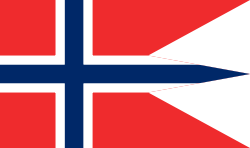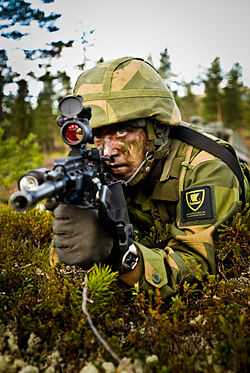Norwegian Armed Forces
| Norwegian Armed Forces Forsvaret | |
|---|---|
 | |
 | |
| Founded | 9th Century |
| Current form | 1990 |
| Service branches |
|
| Headquarters | Akershus Fortress |
| Leadership | |
| Commander-in-chief | King Harald V |
| Minister of Defence | Ine Marie Eriksen Søreide, (H) |
| Chief of Defence | Admiral Haakon Bruun-Hanssen |
| Manpower | |
| Military age | 18-44(55) years of age for male compulsory military service (55 years of age if you are an officer); 16 years of age in wartime; 17 years of age for male volunteers; 18 years of age for women |
| Conscription | 19-month service with 12-month service obligation. Around 50% of conscripts are enrolled in the Home Guard, for a 7-month period (spread out over many years). |
| Available for military service |
1,078,181 males, age 16-55, 1,046,550 females, age 16-55 |
| Fit for military service |
888,219 males, age 16-55, 863,255 females, age 16-55 |
| Reaching military age annually |
31,980 males, 30,543 females |
| Active personnel | 24,450[1] |
| Reserve personnel | 45,250 |
| Expenditures | |
| Budget | US$7.2 billion (2014)[2] |
| Percent of GDP | 1.4% of GDP (2012 est.) List of countries by military expenditures |
| Related articles | |
| History |
World War II ** A selection of engagements / missions only ** |
The Norwegian Armed Forces (Norwegian: Forsvaret, "The Defence") is the military organization responsible for the defence of Norway. It consists of five branches, the Norwegian Army, the Royal Norwegian Navy, which includes the Coast Guard, the Royal Norwegian Air Force, the Home Guard and the Cyber Force, as well as several joint departments. The armed forces number 23,000 personnel, including civilian employees, and have a full-mobilization combat strength of 83,000.[4] Norway employs a weak form of mandatory military service for women and men. While 63,841 men and women were called in for the examination of persons liable for military service in 2012 (mandatory for men), 9265 were conscripted.[5] On 14 June 2013 the Norwegian Parliament voted to extend conscription to women making Norway the first NATO member and first European country to make national service compulsory for both men and women.[6] Among european NATO members, the military expenditure of US$7.2 billion is the highest per capita.
The armed forces are subordinate the Ministry of Defence, led by Ine Marie Eriksen Søreide. The formal commander-in-chief is King Harald V, however, the de facto commander-in-chief is Chief of Defence Haakon Bruun-Hanssen. His staff is located at Akershus Fortress in Oslo, while the Norwegian Joint Headquarters, responsible for commanding operations, is located in Bodø. The main naval base is Haakonsvern in Bergen, the main army camps are in Bardu, Målselv and Rena, and the main air stations are Ørland and Bodø.
An organized military was first assembled in Norway in the 9th century and was early focused around naval warfare. The army was created in 1628 as part of Denmark–Norway, followed by two centuries of regular wars. A Norwegian military was established in 1814, but the military did not see combat until the German occupation of Norway in 1940. Norway abandoned its position as a neutral country in 1949 to become a founding member of the North Atlantic Treaty Organization (NATO). The Cold War saw a large build-up of air stations and military bases, especially in Northern Norway. Since the 2000s, the military has transformed from a focus on defence from an invasion to a mobile force for international missions.
Organization
The Chief of Defence (a four-star general or admiral) heads the armed forces, and is the principal military adviser to the Minister of Defence.
Military branches (in order of seniority):
- Norwegian Army
- Royal Norwegian Navy
- Royal Norwegian Air Force
- Home Guard
- Norwegian Cyber Force
Other main structures, include:
- Special forces
- Defence Staff Norway (DEFSTNOR) in Oslo acts as the staff of the Chief of Defence. It is headed by a three-star general or admiral. DEFSTNOR assigns priorities, manages resources, provides force generation and support activities. Each of the four branches of defence is headed by a two-star general/admiral who are subordinate to DEFSTNOR.
- National Joint Headquarters (NJHQ) located at Reitan, close to Bodø has operational control of Norwegian armed forces worldwide 24/7. It is headed by the Supreme Commander Norwegian Forces - a three-star general or admiral.
- Norwegian Defence Logistics Organization (NDLO) at Kolsås outside Oslo is responsible for engineering, procurement, investment, supply, information and communications technology. It is also responsible for maintenance, repair and storage of material.
Structure
Joint
- 1 National Joint Headquarters in Bodø
- 12 Home Guard districts
- Tactical Mobile Land/Maritime Command
- Special forces
- FSK (Forsvarets spesialkommando).
- MJK (Marinejegerkommandoen).
- Joint ISTAR Unit (Intelligence, Surveillance, Target Acquisition and Reconnaissance)
- Module based ISTAR Unit
- Norwegian Coastal Ranger Command (Kystjegerkommandoen in Norwegian)
- Unmanned aerial vehicle capability
- Airborne Ground Surveillance (joint NATO project)
- Norwegian Home Guard - 50,000 personnel + 33,000 (reserve), rapid reaction forces, follow-on-forces, reinforcement forces and reserves.
- Capacity for information operations
- Norwegian Defence Security Department (NORDSD)
- Flexible medical units
- NRBC protection (Nuclear, radiological, biological, chemical weapons )
- Explosive Ordnance Disposal
- Joint C2I Unit (command, control and information)
- Civil Military Coordination Unit (CIMIC)
- Deployable logistical support
- 2 mobilisation host country battalions (logistics for allied reinforcements)

Norwegian Army
From 1 August 2009 the Norwegian Army changed its structure:[7][8]
- Brigade Nord (operational units)
- Army Weapons School
- HM the Kings Guard
- Garnisonen i Sør-Varanger
- Military Academy
- Logistics and Operational Support
- Operation Support Detachment
Royal Norwegian Navy
- 5 Fridtjof Nansen class Aegis frigates
- 6 Skjold class fast missile boats.
- 6 Ula class submarines
- Mine Warfare Capability
- 6 (8) Oksøy class mine hunter and Alta class mine sweeper
- Mine Clearance Command (divers); HNoMS Tyr support vessel
- Naval Special Warfare Group
- Norwegian Coastal Ranger Command
- Mine Clearance Command (divers)
- Tactical Boat Squadron (CB90-Class fast assault craft)
- Logistics/Support Capacity
- Coast Guard
- 1 Svalbard class vessel
- 3 Barentshav class vessels
- 3 Nordkapp class OPV
- Leased vessels (KV Tromsø and KV Ålesund, KV Harstad, 6 ocean patrol vessels)
- Inner coast guard (25 leased vessels)
- Tug capacity
- Strategic Sealift
Royal Norwegian Air Force
- 72 + 2(1987) F-16 Fighting Falcon about 50-60 operational. (Being replaced by 52 F-35A)
- 2 Air Control Centre/Recognized Air picture Production Centre/Sensor Fusion post (ARS Sørreisa and ARS Mågerø)
- Strategic Airlift / Aerial refueling (common NATO projects)
- Maritime surveillance (4 x P-3C Orion and 2 x P-3N Orion)
- Electronic Warfare (2 + 1 DA-20 Jet Falcon)
- Transport 4x C-130J Super Hercules
- Air Defence Artillery (NASAMS)
- Air Wing for Special Forces (6 x Bell 412)
- 18 Bell 412 transport and light attack helicopters
- 6 NH-90 maritime helicopters (frigates)
- 4 Westland Lynx Special Operations and maritime helicopters (Norwegian Coast Guard)
- Deployable base support
- 12 Sea King search and rescue helicopters
Norwegian Home Guard
- Home Guard (Air, Sea and Land)
Norwegian Cyber Defense Force
- Norwegian Cyber Defense Force
Small arms and handguns
- Heckler & Koch MP5 - replaced by MP7
- Heckler & Koch MP7
- Heckler & Koch HK416 - standard assault rifle
- M320 grenade launcher - used as a grenade launcher on the HK 416 and as a standalone weapon
- Heckler & Koch HK417
- Heckler & Koch G36 - special forces only,
- Colt Canada C7 rifle - special forces only
- Colt Canada C8 rifle - special forces only
- AG3 - former standard assault rifle; currently used by parts of the Home Guard
- Våpensmia NM149
- Barrett M82
- Glock 17 - to be replaced by the MP7 in some areas
- Heckler & Koch USP - in use with some special forces
- Rheinmetall MG3 - will be replaced by FN MINIMI and FN MAG
- FN Minimi
- M2 Browning - known as 12,7 MITR
- ERYX
- BGM-71 TOW
- M72 LAW - light anti-armour weapon
- Carl Gustav recoilless rifle - anti-armour weapon
- FGM-148 Javelin - anti-armour guided missile[9]
References
- ↑ The Military Balance 2013 (2013 ed.). International Institute for Security Studies. 14 May 2013. pp. 160–162. ISBN 978-1857436808.
- ↑ "The Norwegian Defence Budget for 2014". October 15, 2013.
- ↑ "Norsk lyttestasjon viktig brikke i Falklandskrigen". Retrieved 24 December 2014.
- ↑ "Tall og statistikk - Forsvaret.no". NDF. Retrieved 2013-03-18.
- ↑ "NDF official numbers". NDF. Retrieved 2007-07-16.
- ↑ "Norway becomes first NATO country to draft women into military". Reuters. Retrieved 2013-06-15.
- ↑ "Front page - Mil.no" (PDF). Retrieved 24 December 2014.
- ↑ "Front page - Mil.no" (PDF). Retrieved 24 December 2014.
- ↑ "Perfecting the Javelin simulator - the new anti-armor weapon is being phased in this year". Hærens Styrker. 17 March 2009. Retrieved 17 June 2009.
External links
| Wikimedia Commons has media related to Norwegian Armed Forces. |
- Royal Norwegian Ministry of Defence
- Norwegian Defence Force
- One for all, all for one? New Nordic Defence Partnership? Publication from the Nordic Council of Ministers. Free download.
| ||||||||||||||||||||
| |||||||||||||||||||||||||||||||||||||||||||||
| ||||||||||||||||||||
| ||||||||||||||
